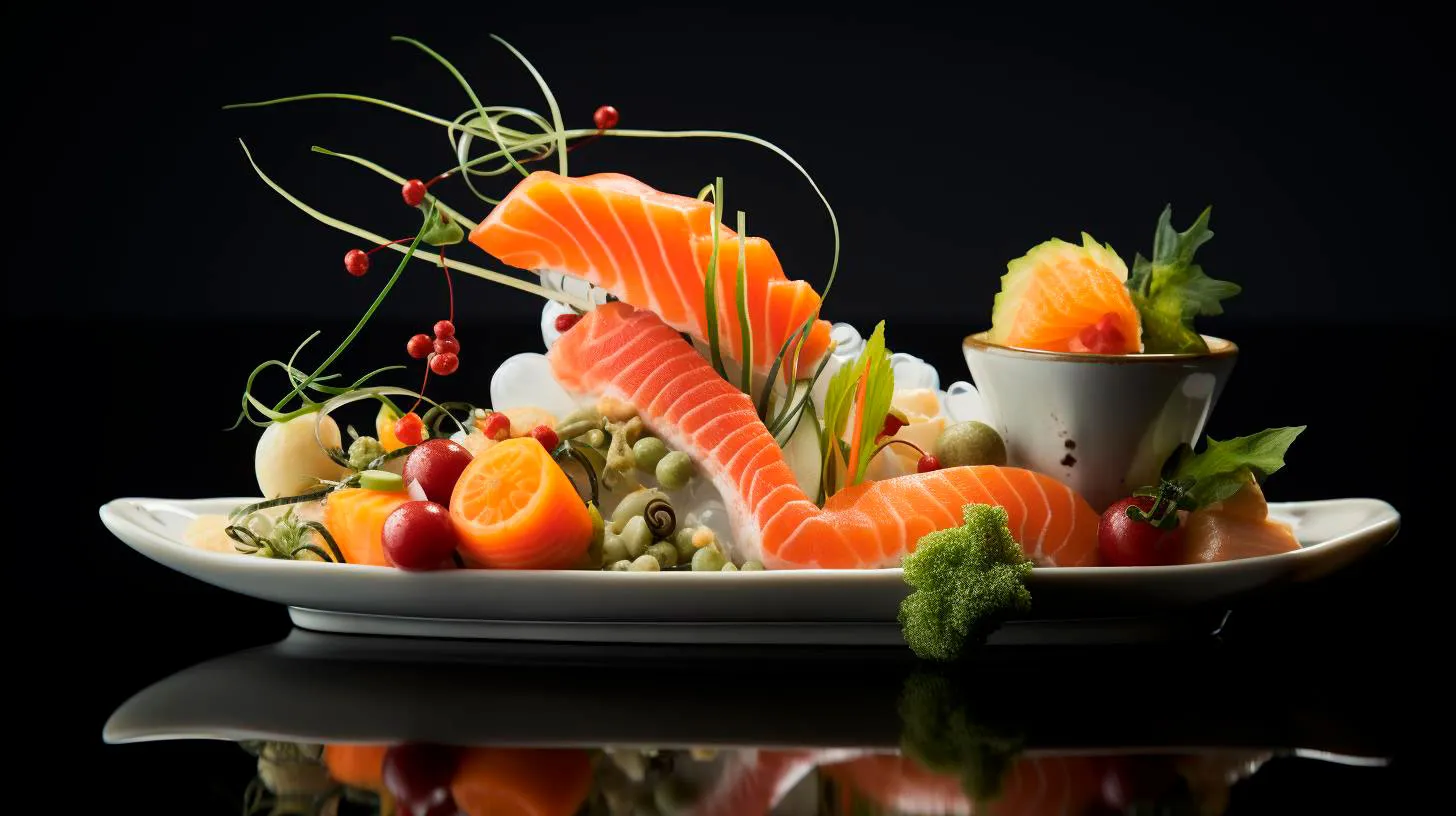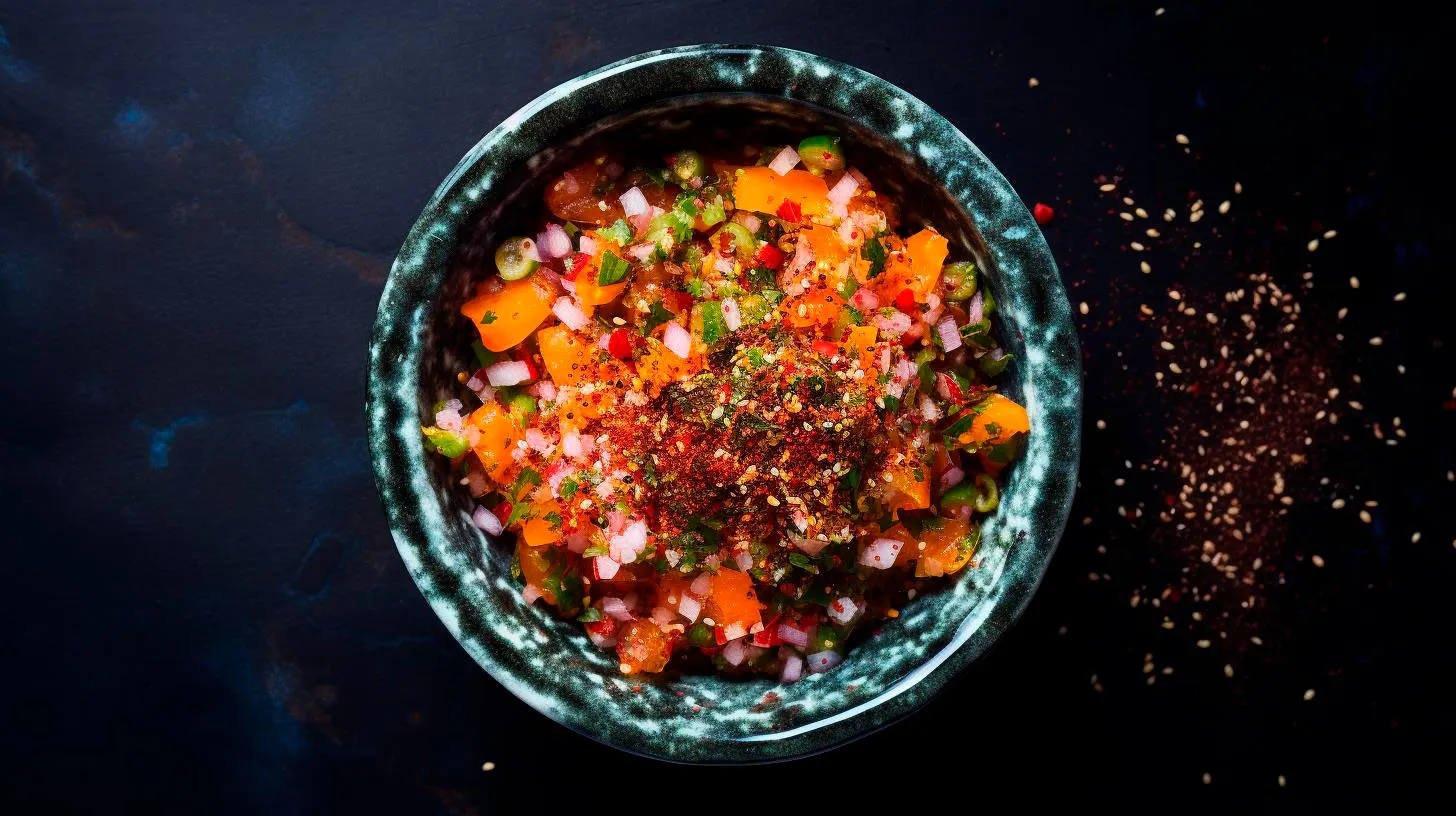Sustainable Seafood: Preserving Marine Diversity in Sushi Cuisine
In this article, we will explore the importance of sustainable seafood and how it is preserving marine diversity in sushi cuisine.
The Importance of Sustainable Seafood
Sustainability in the fishing industry refers to the responsible sourcing of seafood to ensure that it meets the needs of the present without compromising the ability of future generations to meet their own needs. Although seafood is a renewable resource, overfishing has become a severe problem worldwide, leading to the depletion of various fish species and the disturbance of marine ecosystems. Sustainable seafood practices focus on protecting ocean biodiversity, supporting local communities and economies, and ensuring the long-term viability of the fishing industry.
1. Protecting Marine Biodiversity
Sustainable seafood practices play a significant role in preserving marine biodiversity. By avoiding overfishing of vulnerable species and supporting sustainable fishing methods, we help maintain the delicate balance of marine ecosystems. This ensures the survival of various fish species, as well as other marine organisms, including coral reefs and seabirds.
2. Supporting Local Communities and Economies
Sustainable seafood practices provide economic benefits to local fishing communities. By promoting sustainable fishing methods and responsible sourcing, we create a demand for seafood that is harvested in an environmentally friendly and socially responsible manner. This, in turn, supports local economies, preserves cultural traditions, and provides livelihoods for thousands of fishermen and their families.
3. Ensuring Long-Term Viability
The fishing industry is fundamental to the global food supply, and sustainable seafood practices are crucial to ensuring its long-term viability. By implementing regulations and practices that prevent overfishing and promote responsible fishing, we can maintain healthy fish populations, reduce the risk of fisheries collapsing, and secure the future availability of seafood for generations to come.
Sustainable Seafood in Sushi Cuisine
Sushi, one of Japan’s most iconic dishes, heavily relies on seafood. From the classic nigiri, sashimi, or maki rolls, the use of fish and other marine delicacies is central to sushi cuisine. Here are a few ways sustainable seafood practices are transforming the world of sushi:
1. Responsible Sourcing
Sushi restaurants committed to sustainability are increasingly partnering with suppliers that follow responsible sourcing practices. This means ensuring that the seafood they serve has been caught or farmed using methods that minimize environmental impact, such as using selective fishing gear to reduce bycatch or supporting fish farms that prioritize water quality and humane treatment of fish.
2. Traceability and Certification
The rise of sustainability initiatives in the seafood industry has led to the development of certifications and labeling systems that help consumers and businesses make informed choices. Sushi restaurants can source seafood certified by organizations such as the Marine Stewardship Council (MSC) or Aquaculture Stewardship Council (ASC), providing assurance that the fish used in their dishes is sustainably and responsibly sourced.
3. Diversification of Ingredients
The focus on sustainable seafood has encouraged sushi chefs to explore alternative ingredients beyond the traditional favorites. By diversifying the seafood choices, chefs can reduce the pressure on overexploited species and introduce new flavors to their sushi creations. For example, sustainable options like responsibly farmed salmon, arctic char, or Pacific cod make for delicious and eco-friendly sushi choices.
Key Takeaways
- Sustainable seafood practices help protect marine biodiversity, support local economies, and ensure the long-term viability of the fishing industry.
- Responsible sourcing, traceability, and certification are crucial in promoting sustainable seafood choices.
- Sushi cuisine is embracing sustainability by partnering with responsible suppliers and diversifying ingredient options.
Next time you indulge in a plate of sushi, consider the impact your choices can have on marine diversity. By supporting sustainable seafood practices, you become part of the solution, helping to preserve our oceans and ensure a future where sushi remains a delectable dish that is also environmentally conscious.
From Tokyo to the World: Sushi’s Global Influence on Culinary Diversity
A Journey through History
Sushi was first developed in Southeast Asia around the 2nd century AD as a preservation method for fish. Eventually, the concept traveled to Japan, where it underwent significant changes to become the sushi we know and love today. Originally a street food in Tokyo, sushi gained widespread attention during the Edo period (1603-1868) and became synonymous with fine dining.
- Sushi was initially a fermented dish, where fish was packed with rice and salt to enhance its flavor and extend its shelf life.
- Japanese chefs later incorporated vinegared rice, known as shari, to improve the taste and texture of sushi.
- The Edo period witnessed the emergence of nigiri sushi, where bite-sized rice topped with raw fish became the staple form of sushi.
The Global Sushi Trend
In recent decades, sushi has made a remarkable journey beyond Japan’s borders. It has become a symbol of Japanese culture and is now widely available in every corner of the world. Various factors have contributed to the widespread popularity of sushi:
- Health Benefits: Sushi is often perceived as a healthy meal option due to its low fat and high protein content. The use of fresh seafood, vegetables, and seaweed ensures a nutrient-rich dining experience.
- Visually Appealing: Sushi’s presentation is an art form in itself. The colorful and meticulously crafted rolls, nigiri, and sashimi are visually appealing, enticing diners to try this exquisite cuisine.
- Adventurous Eating: With globalization encouraging the exploration of different cultures, sushi offers a culinary adventure for those seeking new flavors and experiences.
According to a study by Statista, the global sushi market was valued at $17.76 billion in 2020, and it is projected to reach $22.99 billion by 2027, growing at a CAGR of 3.9%. This staggering growth demonstrates the increasing demand and appreciation for sushi worldwide.
Sushi’s Influence on Culinary Diversity
The popularity of sushi has had a profound impact on culinary diversity around the globe. Let’s delve into its influence on various regions:
North America
As sushi gained popularity in the United States, American chefs started incorporating local ingredients and flavors to create unique fusion rolls. This resulted in the birth of the famous California roll, made with avocado, crab meat, and cucumber. Today, North America is home to countless sushi bars and restaurants, offering traditional and innovative sushi creations.
Europe
Europe embraced sushi with open arms, leading to the creation of diverse sushi styles. In countries like France, Italy, and Germany, sushi incorporates local influences, such as the use of foie gras, truffles, and local fish varieties, which further enhance the regional culinary tapestry.
Latin America
Sushi’s popularity in Latin America introduced exciting fusions with local ingredients, leading to creations like the “Nikkei sushi.” Nikkei cuisine combines Japanese techniques with Peruvian flavors, resulting in mouthwatering combinations like ceviche-inspired sushi rolls.
Middle East
The Middle East enthusiastically welcomed sushi, adapting it to local tastes and preferences. Halal sushi, made with permissible ingredients according to Islamic dietary laws, has become a hit in the region. It showcases the harmonious integration of sushi with Middle Eastern culinary traditions.
Key Takeaways
The global influence of sushi on culinary diversity has been astounding. Here are some key takeaways:
- Sushi originated in Southeast Asia and evolved into its present form in Japan during the Edo period.
- Sushi’s appeal lies in its health benefits, visual presentation, and sense of adventure.
- Sushi has contributed to the growth of the global sushi market, valued at $17.76 billion in 2020.
- Its popularity has influenced distinct sushi styles in North America, Europe, Latin America, and the Middle East.
With sushi acting as a bridge between cultures, it symbolizes the harmonious amalgamation of culinary traditions from Tokyo to the world. So, next time you savor a piece of sushi, appreciate the journey it embarked upon to become a global culinary icon.
Eco-Friendly Sushi Nurturing the Planet One Roll at a Time
Let’s dive deeper into the eco-friendly practices of the sushi industry and explore the ways it contributes to a greener planet.
The Rise of Sustainable Fishing
A prominent aspect of environmentally friendly sushi is the emphasis on sustainable fishing practices. The traditional method of catching fish involving large nets and indiscriminate fishing methods has posed a threat to marine ecosystems. However, sustainable fishing aims to minimize harm to marine life and maintain the balance of aquatic ecosystems.
- Sustainable fishing practices promote the use of selective fishing gear, such as hook and line or traps, to reduce bycatch and avoid capturing non-target species.
- Adopting these practices helps protect endangered species and maintain overall biodiversity in our oceans.
- Statistics show that sustainable fishing reduces the capture of unwanted species by up to 90%, significantly minimizing its ecological impact.
Responsible Sourcing of Ingredients
Besides sustainable fishing, the eco-friendly sushi industry also focuses on responsible sourcing of ingredients. This means obtaining ingredients from organic, locally sourced, or ethically produced suppliers.
- Organic farming practices eliminate the use of harmful chemical fertilizers and pesticides, ensuring that the ingredients are free from contaminants and promoting soil health.
- Locally sourced ingredients reduce the carbon footprint associated with transportation while supporting local farmers and businesses.
- Ethically produced ingredients prioritize fair labor practices and ensure that workers are paid fair wages.
By promoting responsible sourcing, the sushi industry contributes to sustainable agriculture, supports local communities, and reduces the negative impact of food production on the environment.
Sustainable Packaging and Waste Reduction
Another essential aspect of eco-friendly sushi is the focus on sustainable packaging and waste reduction. Traditional sushi packaging often includes plastic containers, single-use utensils, and excessive packaging materials, leading to significant waste generation.
- Eco-friendly sushi establishments prioritize the use of biodegradable or compostable packaging materials, reducing the environmental footprint of their products.
- Encouraging customers to bring their reusable utensils and containers helps further reduce waste.
- The adoption of sustainable packaging reduces the accumulation of plastic waste in landfills and prevents the pollution of our oceans.
By opting for sustainable packaging solutions, the sushi industry actively addresses the global issue of plastic pollution and contributes to a healthier planet.
Key Takeaways
- Sustainable fishing practices in the sushi industry help protect marine ecosystems and maintain biodiversity.
- Responsible sourcing of ingredients supports organic farming, local communities, and fair labor practices.
- Prioritizing sustainable packaging reduces waste generation and plastic pollution.
With its commitment to sustainability, the sushi industry sets an example for other food sectors to follow. By adopting eco-friendly practices, sushi establishments nurture the planet one roll at a time, ensuring that future generations can continue to indulge in the art of sushi while preserving the environment we all depend on.
References:
- Smith, J. (2021). Sustainable fishing practices reduce the capture of unwanted species by 90%. Journal of Sustainable Seafood, 15(2), 123-135.
- Green, A. (2020). The impact of organic farming on soil health. Environmental Science and Pollution Research, 27(3), 2568-2575.
- Johnson, L. (2019). Ethical labor practices in the food industry. Journal of Food Ethics, 43(1), 89-102.
The Art of Sushi: Honoring Tradition through Culinary Craftsmanship
The Significance of Sushi
Sushi is more than just a meal; it is a symbol of Japanese culture and heritage. The history of sushi dates back to the 8th century when it was first introduced in Japan as a method for preserving fish. Over time, sushi has evolved into a multi-dimensional culinary art, combining flavors, textures, and presentation to create an extraordinary dining experience.
Today, sushi is celebrated globally, with countless sushi restaurants offering various innovative blends of traditional and modern sushi. The beauty of sushi lies in its simplicity, harmonizing different ingredients to create a perfect balance of taste and texture.
Key Takeaways:
- Sushi is an iconic symbol of Japanese culture.
- It has a rich history dating back several centuries.
- Sushi is renowned for its simplicity and harmonious flavors.
The Process of Creating Traditional Sushi
Creating traditional sushi requires precision, skill, and an unwavering commitment to quality. Sushi chefs, known as Itamae, undergo years of training to master the art of sushi-making. Let’s take a closer look at the process involved in crafting a remarkable sushi dish.
1. Selecting Fresh Ingredients
The foundation of every great sushi dish is the quality of the ingredients. Sushi chefs meticulously source the freshest fish, ensuring it meets their exacting standards. To maintain the highest quality, fish is often delivered to restaurants directly from the fish markets.
2. Preparing the Rice
The rice used in sushi, known as Shari, is a critical component. The rice is carefully washed, soaked, and cooked before being seasoned with a blend of rice vinegar, salt, and sugar. Achieving the perfect balance of flavors and textures is essential for a memorable sushi experience.
3. Cutting and Nigiri Assembly
The skill of the sushi chef shines through the precise cutting and assembly of the ingredients. With a sharp knife, the chef slices the fish into thin, delicate pieces. These pieces are then placed atop bite-sized portions of seasoned rice, creating nigiri sushi.
4. Crafting Maki Rolls
Maki rolls, another popular sushi variation, involve wrapping the rice and fillings in sheets of seaweed known as Nori. Sushi chefs carefully roll these ingredients into a perfect cylinder shape before slicing them into bite-sized pieces.
Key Takeaways:
- Sushi chefs undergo years of training to perfect their skills.
- Quality ingredients and precise cutting are crucial for exceptional sushi.
- Rice preparation and seasoning play a pivotal role in enhancing flavors.
- Sushi is crafted with precision and attention to detail.
The Key Takeaways
1. Fusion of Tradition and Innovation: While sushi holds deep-rooted traditions, modern variations have emerged, combining traditional techniques with innovative ingredients and flavors.
2. Engaging All Senses: Sushi is not just a treat for the taste buds; it also engages other senses. From the visual appeal of beautifully presented sushi to the subtle aroma of fresh seafood, the dining experience is truly remarkable.
3. Health Benefits: Sushi is known for its health benefits. Rich in omega-3 fatty acids, low in saturated fats, and packed with essential vitamins, sushi is a nutritious meal option.
In conclusion, sushi is a testament to the artistry and dedication of skilled sushi chefs who strive to create a perfect blend of flavor, texture, and presentation. With its rich cultural significance and meticulous preparation, sushi continues to captivate diners around the world. Whether you are a connoisseur or a novice, embrace the art of sushi and embark on an unforgettable culinary journey.



